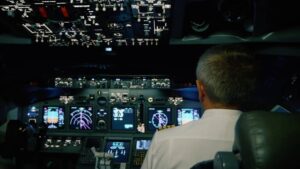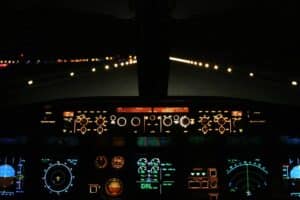Flying at night poses a unique set of challenges in civilian aviation. However, because of the invention of civilian aviation night vision goggles, pilots can now navigate the dark skies more safely and efficiently. While NVGs were designed primarily for military applications, the technology’s great potential has increased its use in civilian aircraft.
In this article, we will delve into the complexity of NVGs, shed light on their working mechanism, importance in civilian aviation, training requirements, and regulating legislation.
Night Vision Technology Mechanisms
Understanding civilian aviation night vision goggles begins with an understanding of night vision technology. This technological marvel operates on the principle of ‘light amplification.’ It collects minute amounts of available light from its surroundings, including infrared light spectrum portions that are ordinarily imperceptible to the human eye. This collected light is then amplified to provide a bright enough image to allow navigating even in near-complete darkness.

Night vision technology is classified into two types: Image Intensification (I2) and Thermal Imaging. The Image Intensification technique creates a crisp image by capturing and magnifying weak amounts of light, such as starlight or moonlight. Thermal imaging, on the other hand, creates images by capturing the higher portion of the infrared light spectrum generated by objects as heat.
The majority of today’s NVGs employ Image Intensification technology. Light photons strike a photocathode and are converted into electrons as part of the functioning mechanism. After flowing through a microchannel plate, these electrons are amplified and converted back into light by a phosphor screen, resulting in a colorful and clear image.
The Rise of Civilian Aviation Night Vision Goggles
Night vision goggles have proven to be a lifesaver in civilian aviation, significantly enhancing the safety and efficiency of nighttime flights. Keeping a visual reference to the surroundings is critical in aviation. This becomes a challenging task in low-light situations, and NVGs provide an effective solution. They give pilots a more precise picture of the ground, which helps them identify potential barriers or threats.
Aside from safety, civilian aviation night vision goggles greatly increase passenger aircraft operational efficiency. They also improve nighttime visibility, allowing pilots to finish operations that would otherwise be delayed or canceled due to insufficient lighting. This is especially useful in locations with fewer daylight hours, as well as during the winter months when daylight is scarce.
Training and Adaptation for NVG Use
The shift to using NVGs in civilian flying is more complex than it appears. Significant training and a period of adaption are required because of the fundamental difference between relying on normal vision and using NVGs.
Pilots must acclimate to the NVGs’ green-hued monochrome image. They must also account for depth perception, light, and a narrow field of view. Furthermore, pilots must be conscious of the actual weight of the NVGs and the pressure they may place on the neck during extended flights.
Pilots are often given extensive training to equip them with the knowledge and skills needed to use civilian aviation night vision goggles successfully. This includes both ground and flight training. Ground training explains the technical aspects of the equipment, highlighting its strengths and weaknesses. On the other hand, flight training is focused on practical application, providing pilots with hands-on experience adapting to the unique challenges of flying with civilian aviation night vision goggles.
The Importance of Civilian Aviation Night Vision Goggles
NVGs have substantially increased the capability and safety of civilian aircraft, opening up new options and efficiency for low-light operations. Here are some of the most significant benefits that NVGs bring to civil aviation:
Increased Security
The obvious benefit of civilian aviation night vision goggles is enhanced safety. With increased sight, pilots can navigate more effectively and notice any hazards or barriers, significantly reducing the possibility of mishaps or crashes during nighttime flights.

Enhanced Operational Effectiveness
Civilian aviation night vision goggles enable operations that would otherwise be delayed or canceled due to low-light conditions to proceed as planned. This results in fewer delays and cancellations, increasing the overall efficiency of aircraft operations.
Expanded Operational Capabilities
Certain fields of civilian aviation, such as air ambulance services, law enforcement, wildlife tracking, and firefighting, can benefit from NVGs. They make nighttime activities safer and more effective, which can be crucial for emergency response and conservation efforts.
Saves Resources
While the initial investment in civilian aviation night vision goggles may be high, they can result in significant cost savings over time. NVGs can help civilian aviation save money by reducing the frequency of delays, cancellations, and potential disasters.
Pilot Confidence and Comfort
Finally, using civilian aviation night vision goggles can significantly increase a pilot’s confidence when flying at night. Pilots may be able to navigate more easily with a clearer view of their surroundings, reducing stress and fatigue associated with nighttime flying.
The Civil Aviation Regulatory Environment for Civilian Aviation Night Vision Goggles
The use of NVGs in civilian flight is governed by national aviation authorities, with standards varying by country. The Federal Aviation Administration (FAA) provides extensive standards for NVG use in the United States. These criteria, which are detailed in Parts 91 (General Operating and Flight Rules) and 135 (Operating Requirements: Commuter and On-Demand Operations), cover a wide range of topics, including equipment requirements and maintenance standards, as well as pilot training and recency requirements.
Furthermore, civilian aviation night vision goggles must meet the requirements established in the Radio Technical Commission for Aeronautics (RTCA) DO-275 standard.
Overcoming Difficulties

While civilian aviation night vision goggles have numerous advantages, their implementation is not without challenges. The biggest concern is the high cost of acquiring NVGs, maintaining them, and training pilots. Technical constraints are also present. In ‘no-light’ conditions, such as heavy fog, NVGs are ineffective. Furthermore, intense lights can cause a ‘halo effect,’ which can cause blinding or blooming and obstruct visibility.
Conclusion
Civilian aviation night vision goggles have completely changed the civilian aviation industry. They increase both safety and operational efficiency during night flights, making them a must-have for pilots. As NVGs advance and develop, making the night sky safer and more accessible for flight operations, we can expect a greater reliance on them in the future. Despite the challenges and regulatory constraints, the numerous benefits given by civilian aviation night vision goggles make them an indispensable component of modern-day civilian aviation.

